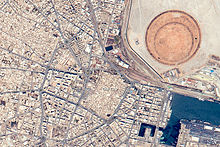
Phosphogypsum (PG) is the calcium sulfate hydrate formed as a by-product of the production of fertilizer, particularly phosphoric acid, from phosphate rock. It is mainly composed of gypsum (CaSO4·2H2O). Although gypsum is a widely used material in the construction industry, phosphogypsum is usually not used, but is stored indefinitely because of its weak radioactivity caused by the presence of naturally occurring uranium (U) and thorium (Th), and their daughter isotopes radium (Ra), radon (Rn) and polonium (Po). On the other hand, it includes several valuable components—calcium sulphates and elements such as silicon, iron, titanium, magnesium, aluminum, and manganese.[1] However, the long-range storage of phosphogypsum is controversial.[2] About five tons of phosphogypsum are generated per ton of phosphoric acid production. Annually, the estimated generation of phosphogypsum worldwide is 100 to 280 million metric tons.[3]

- ^ Chernysh, Yelizaveta; Yakhnenko, Olena; Chubur, Viktoriia; Roubík, Hynek (2021). "Phosphogypsum Recycling: A Review of Environmental Issues, Current Trends, and Prospects". Applied Sciences. 11 (4): 1575. doi:10.3390/app11041575.
- ^ Ayres, R. U., Holmberg, J., Andersson, B., "Materials and the Global environment: Waste Mining in the 21st Century", MRS Bull. 2001, 26, 477. doi:10.1557/mrs2001.119
- ^ Tayibi, Hanan; Choura, Mohamed; López, Félix A.; Alguacil, Francisco J.; López-Delgado, Aurora (2009). "Environmental Impact and Management of Phosphogypsum". Journal of Environmental Management. 90 (8): 2377–2386. Bibcode:2009JEnvM..90.2377T. doi:10.1016/j.jenvman.2009.03.007. hdl:10261/45241. PMID 19406560. S2CID 24111765.
- ^ Stéphanie Wenger, « Tunisie : comment Sfax veut récupérer « sa » mer », La Tribune, 29 juillet 2013